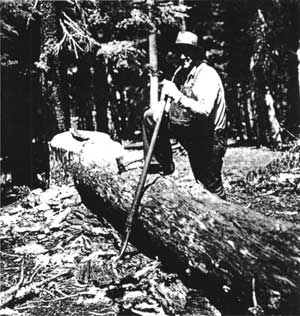I believe that the work in the past two years on this project shows quite definitely that this beetle can be controlled when funds are available for thorough work and where flight from the outside is not a factor. I can not help but feel from the experience of the past few years that thorough initial work is the key to the success of many of these beetle control projects and in different work, although not intentionally so. is the explanation for some of the poorer results which have been so disconcerting.
|
|
The “maintenance” control work in 1933 marked the first use of Civilian Conservation Corps (CCC) crews in insect control in the park. The men arrived from the east just as control work was to begin, and eventually 200 young men were treating trees. Even though they lacked experience using tools and working in the woods, they were given high praise by Frank Solinsky for their eagerness to learn and willingness to work hard to prove themselves. [43] The Park Service treated 7,026 trees that season in the old units. Most of the trees were killed by mountain pine beetle, but over 100 trees were mountain hemlock (Tsuga mertensiana (Bong.) Carr.) and white fir (Abies concolor (Gord. & Glend.) Lindl. ex Hildebr.) killed by other insects (see footnote 43). Solinsky also noted that the Sun Pass infestation was not treated for the second year in a row because of a lack of funds. He also noted that very cold temperatures during the winter 1932-33 caused mountain pine beetle brood mortality in the park and at Sun Pass. Temperatures recorded at the park were -14°F in December and -16°F in February—enough to kill at least some insects under the thin-barked lodge pole pine. Solinsky thought that only 1,000 trees would need treating in 1934 (see footnote 43).
Correspondence for 1933 indicates that neither Keen nor Buckhorn participated in the control work that spring. They were evidently busy moving their office and laboratory in Portland, OR, and doing research on western pine beetle in other areas. Patterson also rejoined the Bureau of Entomology that summer and was put in charge of CCC insect control for the Stanislaus National Forest in California. He promptly got Frank Solinsky a job at the Stanislaus for the remainder of that season as a bug spotter. [44] The end of the season found Keen and Craighead visiting the park and finding very few infested trees. They noted that perhaps the CCC crews could treat the Sun Pass area and finally end that threat to the Park. [45]
By 1934, only 21 lodgepole pine infested with mountain pine beetle were treated. The battle was finally over. A survey of the old control areas in the park by Buckhorn in October 1934 found less than 500 infested trees, and over half of these did not have enough brood to justify treatment. He recommended that no control be under taken in 1935 against mountain pine beetle except in recreation centers. [46] Buckhorn did report that the Sun Pass infestation, though reduced by winter kill of beetle broods in 1932-33, had rebounded in 1934. That spring the Forest Service treated nearly 6,000 trees by using CCC crews. Buckhorn recommended that the estimated 2,000 trees infested in fall 1934 be treated in 1935 to stamp out this infestation (see footnote 46).
***previous*** — ***next***


